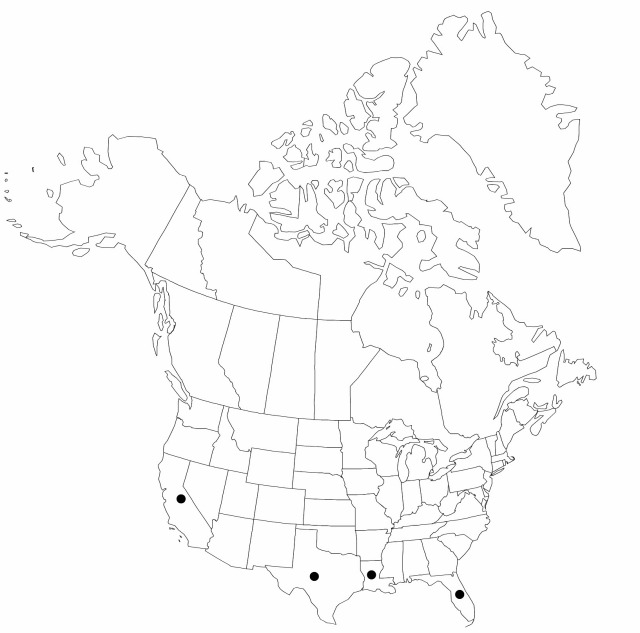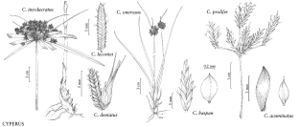Cyperus involucratus
Descr. Pl. Rar., 22. 1772.
Herbs, perennial, cespitose, rhizomatous. Culms trigonous, 30–150 cm × 1–5 (–8) mm. Leaves bladeless. Inflorescences: heads digitate, 15–30 (–36) mm diam.; rays (14–) 20–22, (2–) 5–12 (–20) cm; 2d order rays 0.3–3 (–4) cm; 3d order rays sometimes present, 0.3–2.5 cm; bracts (4–) 18–22, ± horizontal, flat, 15–27 cm × (1.5–) 8–12 mm. Spikelets 8–20, ovoid to linear-lanceoloid, compressed, 5–25 × 1.5–2 mm; floral scales 8–28, laterally whitish or light-brown, ± hyaline, medially light-brown, laterally ribless, medially 3-ribbed, 2-keeled in proximal 30–60%, deltate-ovate, 1.6–2.4 × (1–) 1.2–1.5 (–1.7) mm, apex acute. Flowers: stamens 3; anthers 0.7–1 mm; styles 0.5–1 mm; stigmas 0.6–1 mm. Achenes brown, sessile or stipitate, broadly ellipsoid, 0.6–0.8 × 0.4–0.6 mm, stipe if present to 0.1 mm, apex obtuse, apiculate, surfaces puncticulate.
Phenology: Fruiting early summer–fall.
Habitat: Damp, disturbed soils, ditches, stream banks
Elevation: 0–100(–800) m
Distribution

Introduced; Calif., Fla., La., Tex., e Africa
Discussion
Cyperus involucratus has been collected in New York (R. S. Mitchell and G. C. Tucker 1997).
Cyperus involucratus is widely cultivated as a water plant in greenhouses and outdoors in warm-temperate or tropical climates. It has long been misidentified in the flora as C. alternifolius Linnaeus, an endemic of Madagascar (G. C. Tucker 1983).
Selected References
None.
Lower Taxa
"shortened" is not a number.
